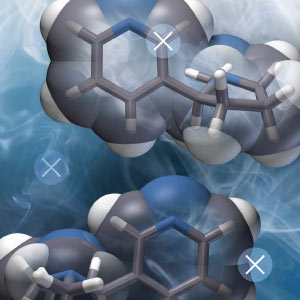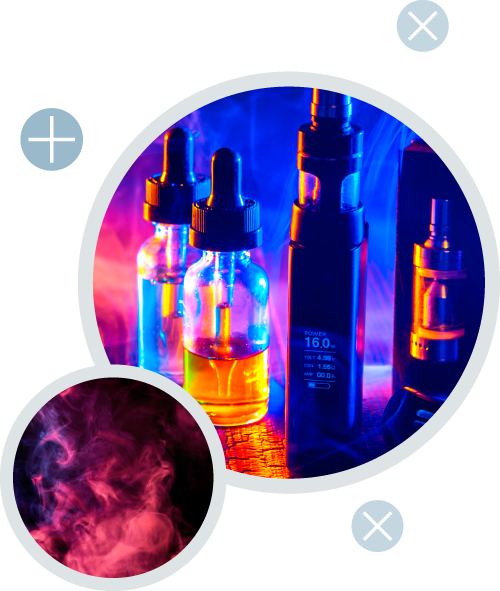A number of approved, subsidised smoking cessation aids are available in New Zealand, including:
- Nicotine replacement therapy (NRT) such as patches, gum or lozenges
- Bupropion
- Varenicline, subject to Special Authority approval
- Nortriptyline
Evidence shows that approved smoking cessation aids in combination with behavioural support help the highest percentage
of smokers to quit.10
When discussing smoking cessation, it is often necessary to address misconceptions about the risks associated with NRT,
and explain that it is the method of delivery of nicotine (i.e. smoking cigarettes) that poses the greatest risk, rather
than nicotine itself (see: “Misconceptions about nicotine”).
For further information on:
Misconceptions about nicotine

Although nicotine is addictive and drives continued smoking, the principal cause of smoking-related morbidity is the
complex mix of combustion products from tobacco, such as particulate matter and tar, carbon monoxide, ammonia, formaldehyde,
benzene, acrolein and toluene.5, 11 Inhalation of the over 7000 chemical constituents of cigarette smoke
causes cancers, cardiovascular and respiratory diseases through a variety of mechanisms.5, 11
It is therefore important to address any misconceptions about nicotine with smokers who wish to quit, and reassure
them that using nicotine-containing products such as NRT poses a significantly reduced risk to their health. Surveys
conducted in New Zealand and overseas show that there is confusion over the risks associated with smoking, smoking cessation
aids and vaping with many people believing it is the nicotine content which is harmful:
- Just over half of adults agreed that NRT was safer than smoking12
- Four out of every ten current or ex-smokers believed that nicotine in cigarettes was the cause of most smoking-related
cancer12
- Only 38% of people agreed that vaping was safer for health than smoking13
If asked about vaping, health care professionals can explain that it is not an approved or recommended method of smoking
cessation, but it may help smokers to quit if other attempts have failed, and will be less harmful to their health than
continuing smoking. Smokers may need to trial different strengths of nicotine and flavours of vaping liquids in order
to find one which helps them quit. Ideally, vaping should be viewed by smokers as an interim measure with the goal of
quitting smoking and subsequently also quitting vaping. Behavioural smoking cessation support should be continued.
Vaping devices are not approved smoking cessation aids but may help some people to quit
Vaping has entered into public use as a consumer product, and no vaping devices are approved by Medsafe as smoking cessation
aids. Vaping devices and liquids are not subject to the same regulatory assessments for safety that would be required
of an inhaled medicine. For example, manufacturers of medical devices are required to inform Medsafe of alterations to
their products, but the components included in vaping liquids or the design or manufacture of vaping devices are not subject
to the same oversight.
There are few randomised controlled trials assessing the effectiveness of vaping as a smoking cessation aid, and the
majority of published data come from observational studies or reports from smoking cessation services. The data suggest
that vaping may help people to quit smoking by approximately the same extent as approved nicotine replacement therapy
(NRT) products.5, 12 For example, in one clinical trial conducted in Auckland, over 650 smokers were randomised
to vaping with nicotine-containing liquids, vaping without nicotine, or using nicotine replacement patches. After six
months, rates of smoking cessation were similar for all three groups with between 4–7% of participants remaining continuously
abstinent.14
Smokers who switch to vaping with nicotine-containing liquids are more likely to quit
Vaping using liquids containing nicotine appears to be slightly more effective at helping smokers to quit than using
liquids without nicotine: out of 1,000 people, approximately 53–64 more will manage to quit smoking by vaping using nicotine-containing
liquids compared to liquids without nicotine (number-needed-to-treat [NNT] of approximately 15–20).15, 16
Smokers who wish to try vaping can be given advice to begin with a higher strength nicotine-containing liquid. The nicotine
strength should then be gradually reduced, until nicotine is no longer required. Vaping should then be ceased.
Smokers who begin vaping should stop using cigarettes
The majority of studies have found that smokers who begin vaping reduce the number of cigarettes they smoke.12,
17 For example, in the study conducted in Auckland, participants randomised to vaping products smoked five to ten
fewer cigarettes per day.18 Smoking fewer cigarettes will lead to a lower exposure to toxic and carcinogenic
substances in tobacco smoke. However, smokers should be encouraged to quit altogether as evidence shows that even low
levels of smoking or low exposures, such as via second hand smoking, are associated with significantly increased health
risks compared to not smoking.19, 20 For example, a 2018 meta-analysis found that people smoking 20 cigarettes
per day had 2.3 to 4 times the risk of coronary heart disease or stroke as non-smokers. In comparison, people smoking
one cigarette per day had 1.7 to 2.2 times the risk of non-smokers.20
Vaping is likely to be substantially less harmful than smoking
Current medical consensus in the United Kingdom and United States is that vaping is likely to be substantially less
harmful than smoking.5, 12, 21 For example, a review by Public Health England concluded that vaping is likely
to be 95% less harmful than smoking.12
In New Zealand, the Ministry of Health considers that vaping could contribute to achieving smokefree targets and reduce
health inequities, although this is dependent on how many people use vaping to help them quit smoking and how many people
use vaping as an avenue into smoking (see: “Vaping products should only be used by smokers”).6
Non-smokers should be strongly encouraged not to start vaping. However, current evidence suggests that
very few non-smokers regularly use vaping devices.6
Pregnant women should avoid vaping. The effects of vaping during pregnancy on fetal development have
not been sufficiently studied, however, evidence from animal studies suggests it may be associated with some harm.22 Smoking
should also be avoided during pregnancy.
Aerosol from a vaping device contains fewer and lower levels of toxic components than cigarette smoke
In studies conducted to date, vaping aerosol has been found to contain fewer and lower levels of the carcinogens and
toxic components of tobacco smoke.5 For example, toxic components such as formaldehyde, acetaldehyde and toluene,
are present in vaping aerosol in quantities 9 to 450 times lower than in cigarette smoke.5 A recent review
by the Royal College of Physicians in the United Kingdom concluded that under normal use the levels of toxins in vaping
aerosol would “probably be” well below designated thresholds for occupational exposure.3
The flavourings used in vaping liquids are also used to flavour foods and are considered safe for oral ingestion, however,
the risks associated with inhaling them as a vapour are unclear.3 Current opinion is that this is the most
likely aspect of vaping to pose a future health risk, although the extent of risk is unknown.3 For example,
some vaping liquids were previously found to contain diacetyl, which is a cause of bronchiolitis obliterans, also known
as popcorn lung, in people subject to high workplace exposures of this chemical. Although reports suggest manufacturers
have removed diacetyl from vaping liquids, and there was no direct evidence of harm, vaping products are not subject to
regulation and other risks may arise if changes to vaping liquids or devices occur in the future.12
Smokers who switch to vaping have short-term improvements in health
The most common short-term adverse effects associated with vaping include mouth and throat irritation, a dry cough of
mild to moderate severity, anxiety, insomnia and depression.17 Short-term studies have found that smokers who
switch to vaping have improvements in markers of cardiovascular risk, lung function and symptoms of respiratory disease.
These include reduced blood pressure, fewer exacerbations of chronic obstructive pulmonary disease (COPD) and improvements
in asthma symptoms.1 Biomarkers of exposure to carcinogens in cigarette smoke are reduced in smokers who switch
exclusively to vaping, i.e. do not continue to smoke as well as vape, and it is expected that this would translate to
a reduced risk of cancer.14 Smokers also rate their own health as improved when they switch to vaping.5 The
long-term health effects of vaping are currently unknown.

Vaping products should only be used by smokers: strongly encourage non-smokers not to start
There have been concerns that the marketing of vaping products could encourage non-smokers to begin vaping, particularly
young people. To date, evidence from New Zealand and overseas has found the majority of people who use vaping products
are smokers or ex-smokers, with few young people taking up vaping.5, 12, 26 Among adolescents in New Zealand
aged 14–15 years surveyed in 2016, 15% had tried vaping at some point, however, the majority of this group reported vaping
less than once a month.26 It is illegal in New Zealand to sell vaping products to people aged under 18 years.27
Clinicians should encourage non-smokers not to initiate vaping as although the long-term health effects are unclear,
it is likely to be associated with some degree of harm.12 Nicotine is the main factor contributing to the
addictive potential of cigarettes and non-smokers who begin vaping with nicotine-containing liquids place themselves at
risk of becoming addicted.
Further information on Smoking advice for adolescents available from
Smoking prevention and cessation in adolescents: changing futures, saving lives bpacNZ, June 2013
The legal ban on smoking indoors does not currently apply to vaping products, however, this may change.6 Levels
of nicotine and particulate matter in the air from vaping are lower than from cigarette smoking and there is currently
no available evidence on the potential long-term health effects of second-hand inhalation of vaping aerosol.5, 23
Ask smokers who switch to vaping to consider people around them and avoid vaping in situations or locations where the
vapour will be a nuisance to others. Practices can decide whether to include vaping in their workplace smokefree policies.6
People who vape can be recorded as ex-smokers
Smokers who fully switch to vaping can be classified as ex-smokers in their medical notes once they have not smoked
a cigarette for 28 days.24,25 The key factor determining coding of smoking behaviour is whether a person smokes
cigarettes, not whether they are using nicotine, e.g. NRT products or vaping.25 People who continue to smoke
cigarettes while using vaping products should remain classified as current smokers.24
Clinicians should record in a patient’s notes if they are using vaping products, in order to monitor for any adverse
effects of vaping that may become apparent in the future.
Summary: how to incorporate advice on vaping into smoking cessation discussions
For smokers who are considering vaping, health care professionals can highlight that:5, 12
- The adverse health effects associated with smoking primarily derive from inhaling tobacco smoke, not the nicotine
content of cigarettes
- Vaping is less harmful than smoking but unlikely to be without harm; the long-term effects are unknown and products
are not regulated
- Vaping may help them to quit smoking
- Vaping costs less than smoking, but NRT or smoking cessation medicines can be prescribed to them fully subsidised
- It is likely that they will derive the most benefit from using nicotine-containing vaping liquids and gradually reducing
the strength until they no longer require nicotine, at which point vaping should be stopped
- Vaping devices should be kept away from children due to the risk of nicotine poisoning from ingestion of vaping liquids
- Behavioural smoking cessation support should be continued
Further information on smoking cessation available from
Update on smoking cessation bpacNZ, December 2010
Patient information: stop smoking services
A list of local stop smoking services is available at:
Smokefree Stop smoking services
Contact Quitline by:





